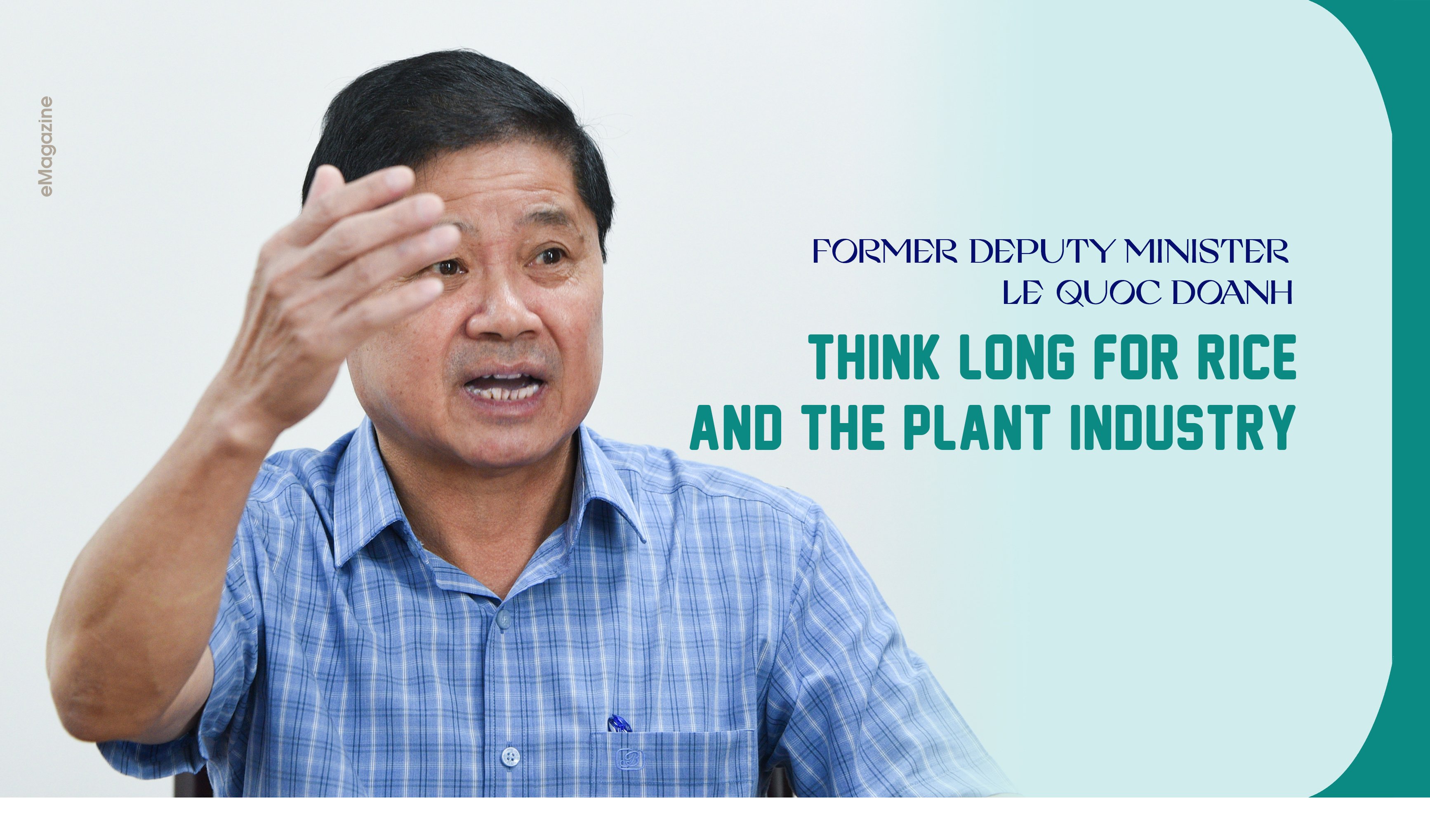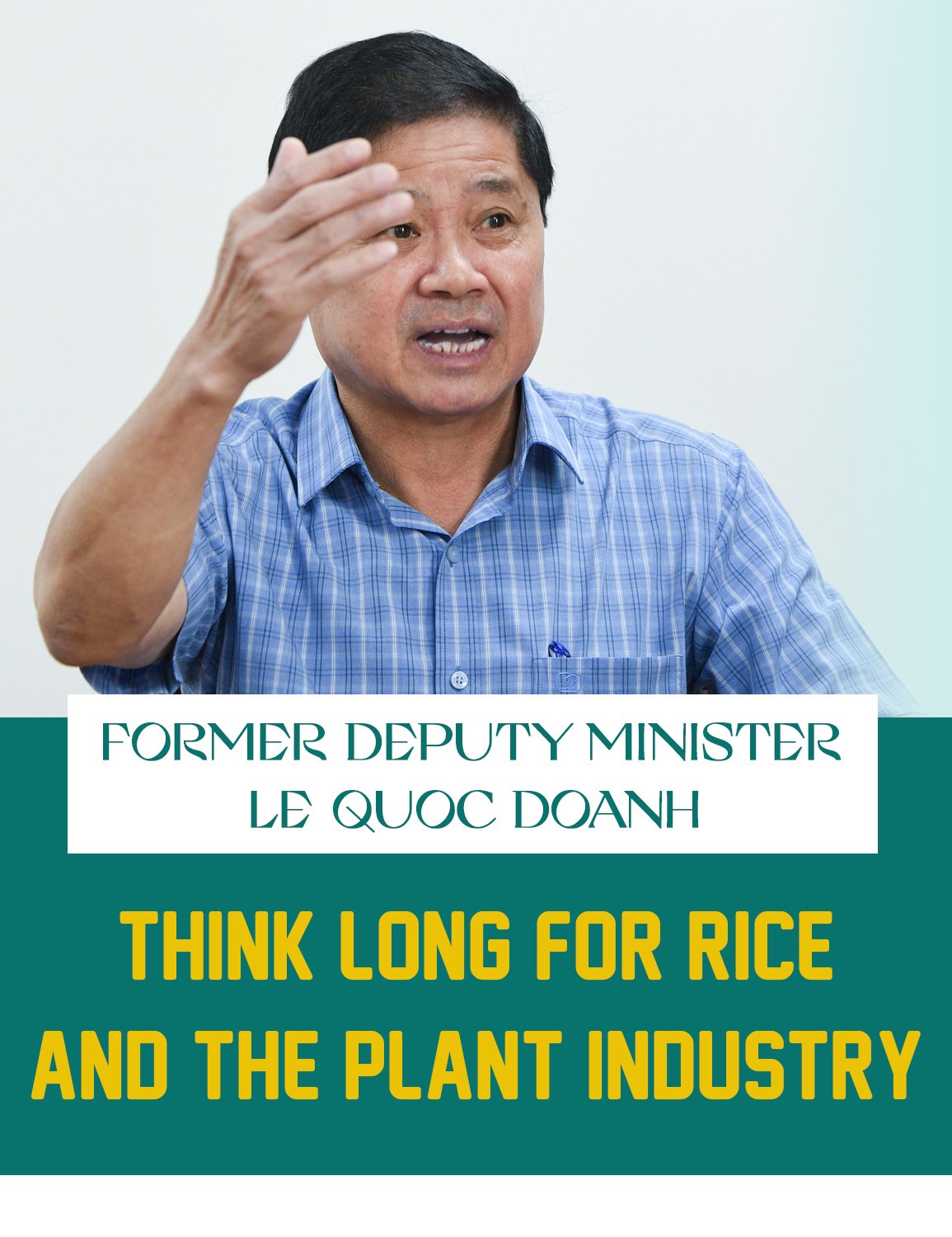From the story of rice, which is very topical at present, to many other crops in the field of farming, from strategic development thinking to solutions, concerns, and even the feelings of a person attached career with rice and crops... The exciting conversation between Journalist Tran Cao, Deputy Editor-in-Chief of Vietnam Agriculture Newspaper and Former Deputy Minister of Agriculture and Rural Development Le Quoc Doanh was frank and suggested many things.
Former Deputy Minister Le Quoc Doanh said: Rice or planting is a field that is considered a measure of the country's development, linked to all Vietnamese people, so when viewed not only in each moment but very long term.

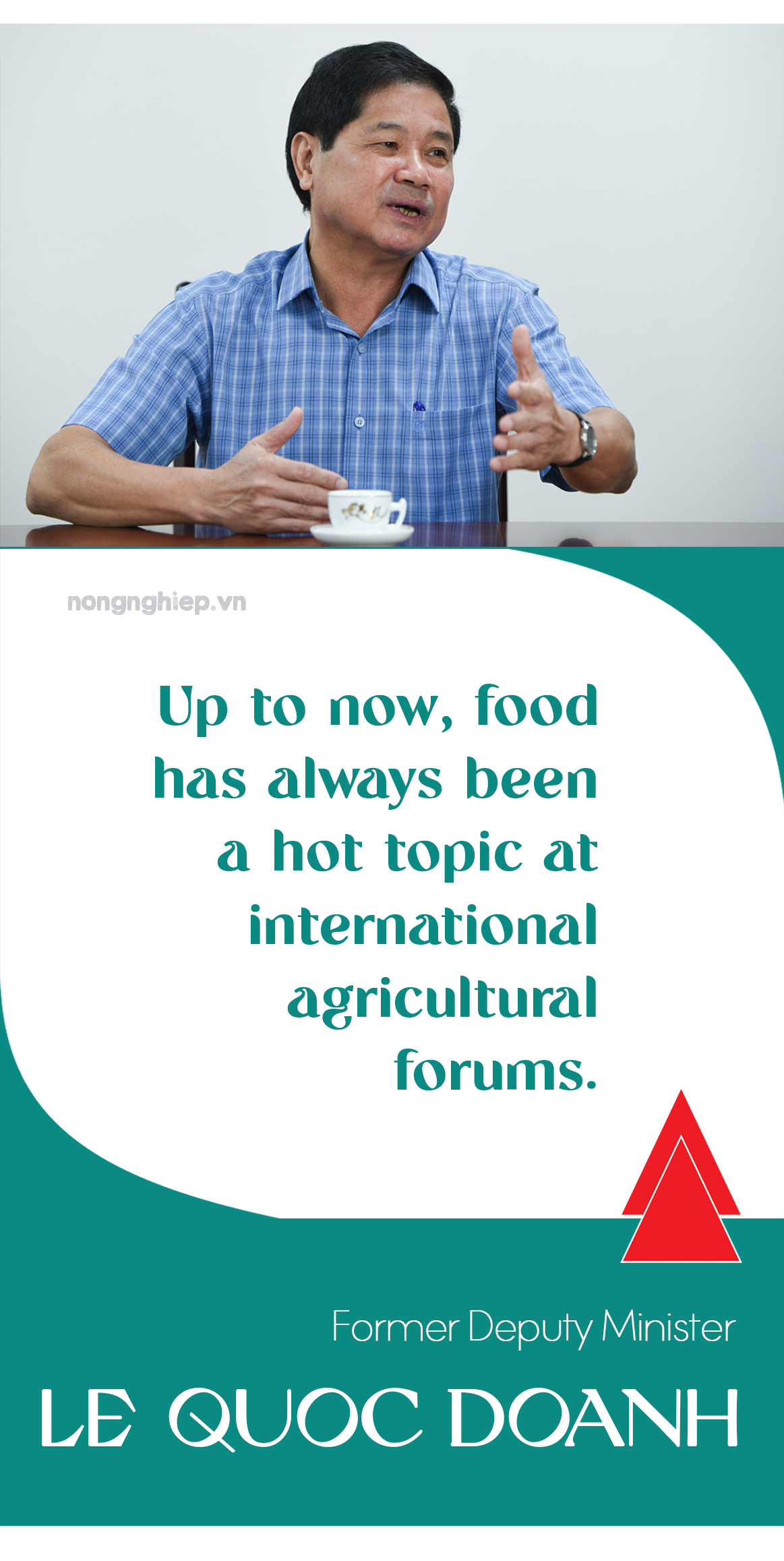
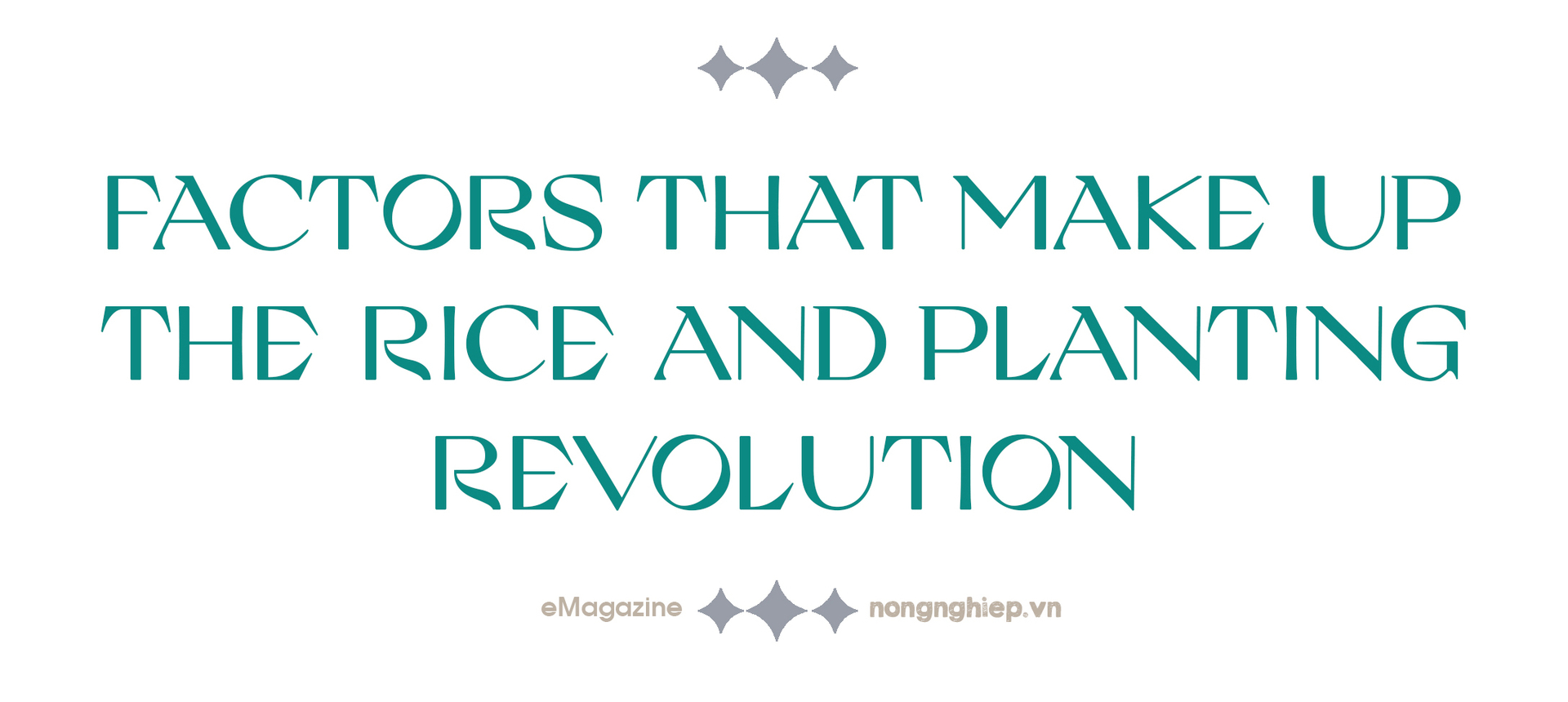
Journalist Tran Cao: Sir, in the first 7 months of 2023, the world context continues to have many fluctuations. However, rice and some other cultivated commodities have many bright spots. Typically, fruit and vegetable exports reached US$ 3.23 billion (up 68.1%), rice exports reached US$ 2.58 billion (up 29.6%), cashew nut exports reached US$ 1.95 billion (up 9.8%), coffee exports reached US$ 2.76 billion (up 6%). That seems to indicate sustainable development and the result of a long-term development strategy. In other words, today's results are the preparation for a long time ago. What do you think?
Former Deputy Minister Le Quoc Doanh: 2023 can be said to be a very special year. After Covid-19, we see the global economy falling into difficulty. In such a common picture, we are still happy because Vietnam's economy is growing and developing sustainably.
The agricultural sector stands out in production and export and has impressive growth sectors such as rice, coffee, vegetables, and fruits... Regarding the achievements of the rice story, specifically some trees in the planting field, I want to share a few lessons learned from my personal views.
The agricultural industry has 4 main export groups (Cultivation, Livestock, Fisheries and Forestry). The export turnover of the entire industry in the past 7 months decreased by 9% compared to the same period in 2022, but the group of products from planting alone increased. Especially in this group, there are groups with very high increases of export turnover, such as vegetables, fruits, rice...
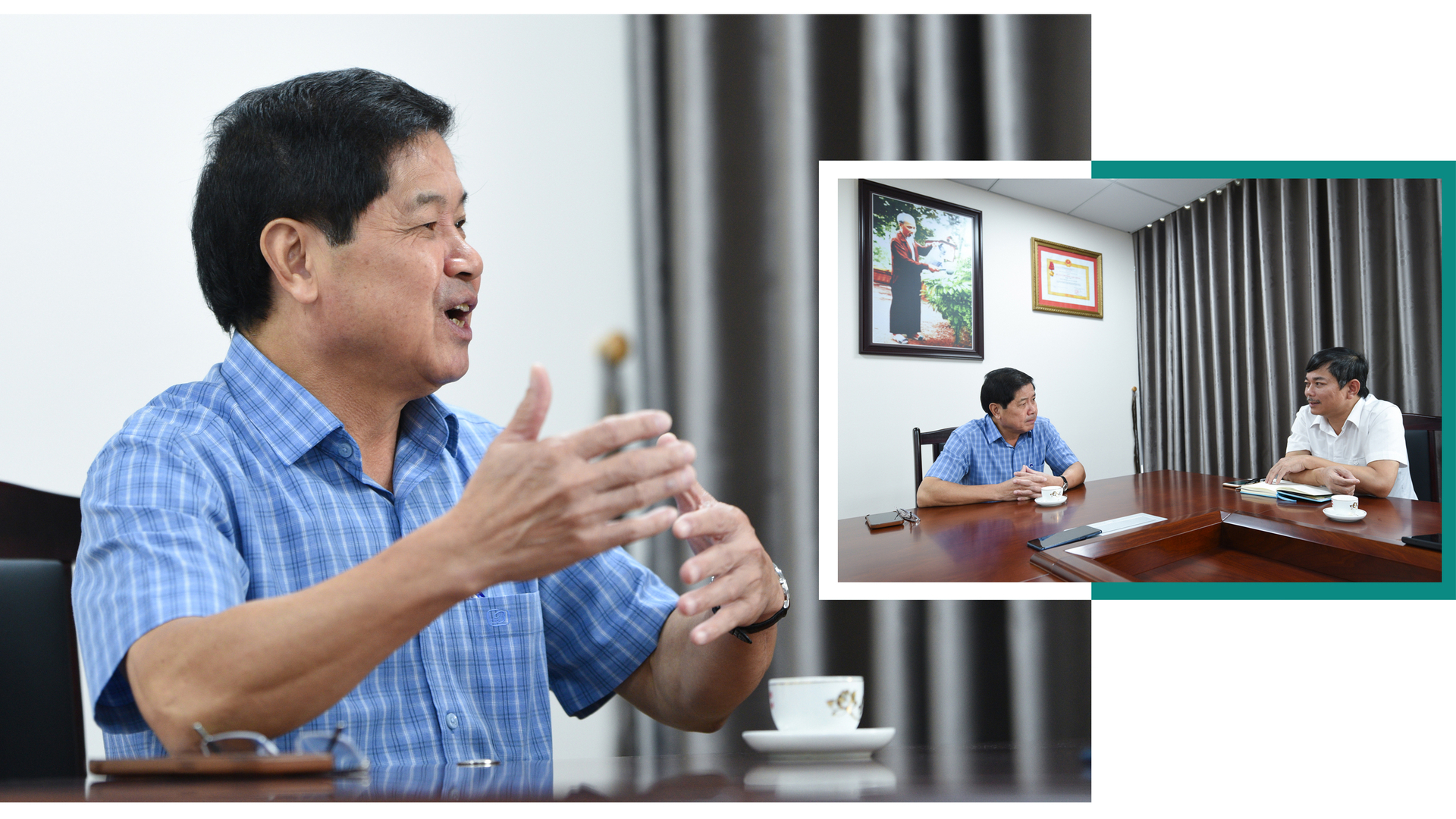
As you said, it shows that it results from sustainable development. We maintain output and productivity despite frequent unpredictable epidemics and natural disasters over the past 10 years. Furthermore, this is an essential group of goods. People can have difficulties; they can cut down on this or that, but they still cannot cut down on food. The COVID-19 pandemic, the Russia-Ukraine conflict, climate change, El Nino... further show food's critical role.
Food is always the hottest topic, always the first. In 2008, I went to the International Rice Research Institute and was interviewed by the international press, asking whether the leading rice exporting countries had restricted it. What was Vietnam's view? After exactly 15 years of this, many leading rice exporting countries are now banning or stopping, causing a limited supply of rice and other grain products, while the need for essential food can not be cut.
Stories above confirm that the plant industry has a methodical development strategy and is steadfast in that strategy, based on scientific research, identifying the industry's potential and competitive advantages, inheritance from generations, and many other factors to make appropriate development decisions.
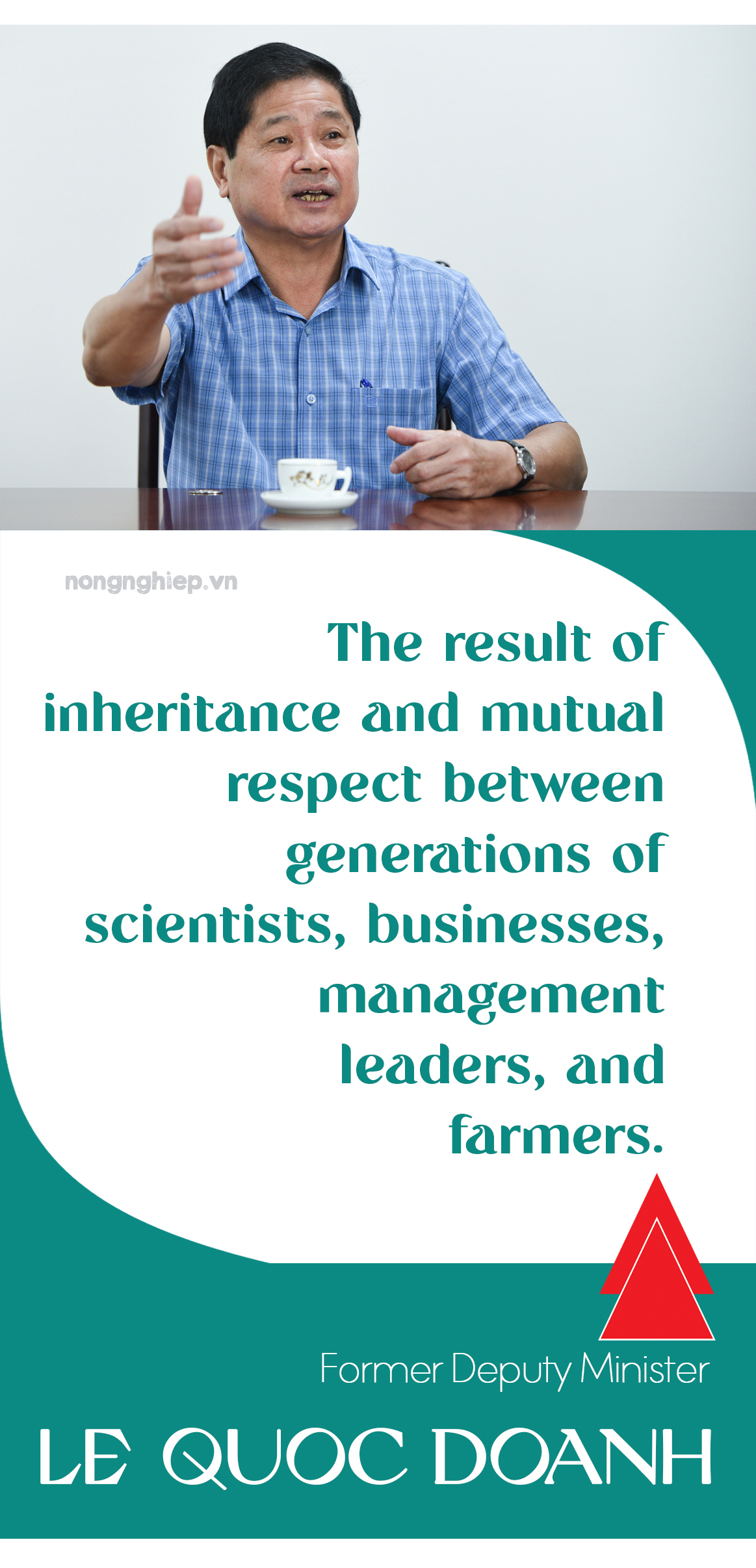
Journalist Tran Cao: Sir, regarding to inheritance, I think rice and planting, is probably one of the fields with a vast amount of scientific research, a long tradition, the application of scientific advances, and strong technical training... Is that the basis for us to be steadfast in our industry development strategy and the fundamental factors that create the overall achievements of rice and plant industry today?
Former Deputy Minister Le Quoc Doanh: My working life, 28 years at the Vietnam Academy of Agricultural Sciences and more than 10 years in state management at the Ministry, has been associated with rice and plants. This is a field we have inherited from many generations of management leaders, generations of scientists, and even generations of farmers. We accumulate small to great, step by step, perfecting and developing.
In the development and innovation of Vietnamese agriculture, rice is often used to measure the country's development. The growth of the agricultural sector also depends on rice, or in other words, rice is associated with wet rice civilization, with people's lives, and the results of farmers' labor. Cultivation keeps growing, and we have all the advantages up to this point.
Our land does not have many advantages. In particular, agricultural land has to compete with many other types of land. Population growth, residential land, industrial land, tourism and other services... so what advantages do we have to put on the table now?
Firstly, rice cannot be abandoned, then fruit trees, coffee trees, forestry trees... The effectiveness of coffee trees is increasingly seen, especially in the Central Highlands. We just had a low price cycle, nearly 10 years, and we persevered. When I went to meetings at the International Coffee Organization, I always brought up the lesson of Vietnam: productivity.
The world's coffee yield is 0.8 tons/ha. Vietnam's is approximately 3 tons/ha, and even Lam Dong is about 3.5 tons/ha. At a time, the price fell below VND 35 million/ton, but thanks to the productivity, farmers could earn over VND 100 million/ha and the coffee garden was not destroyed. Now that prices are high, coffee growers will become rich.
In addition, we also have tropical fruit trees everywhere. Like cashews, trees cover once bare land on bare hills, which is also an advantage. In some areas, cashew productivity is not as high as expected, but it isn't easy to grow any other crop.
When calculating the advantage, it is multifaceted. Not every tree is millions or billions of dollars. For example, with citrus trees, oranges are grown in many places, but it must be said that it is difficult to compete. Therefore, it is necessary to summarize, inherit, and perfect, looking at the world market with many factors.
The second is that in terms of science, the role is huge. Scientific evaluation cannot be done in one year or a short period but must be a whole process from testing, evaluating, disseminating, and testing into one process.
I am so happy. From small processes, we are gradually perfecting technical packages for many crops, especially rice, coffee and some fruit trees. We have good models, very efficient at scale out of production.
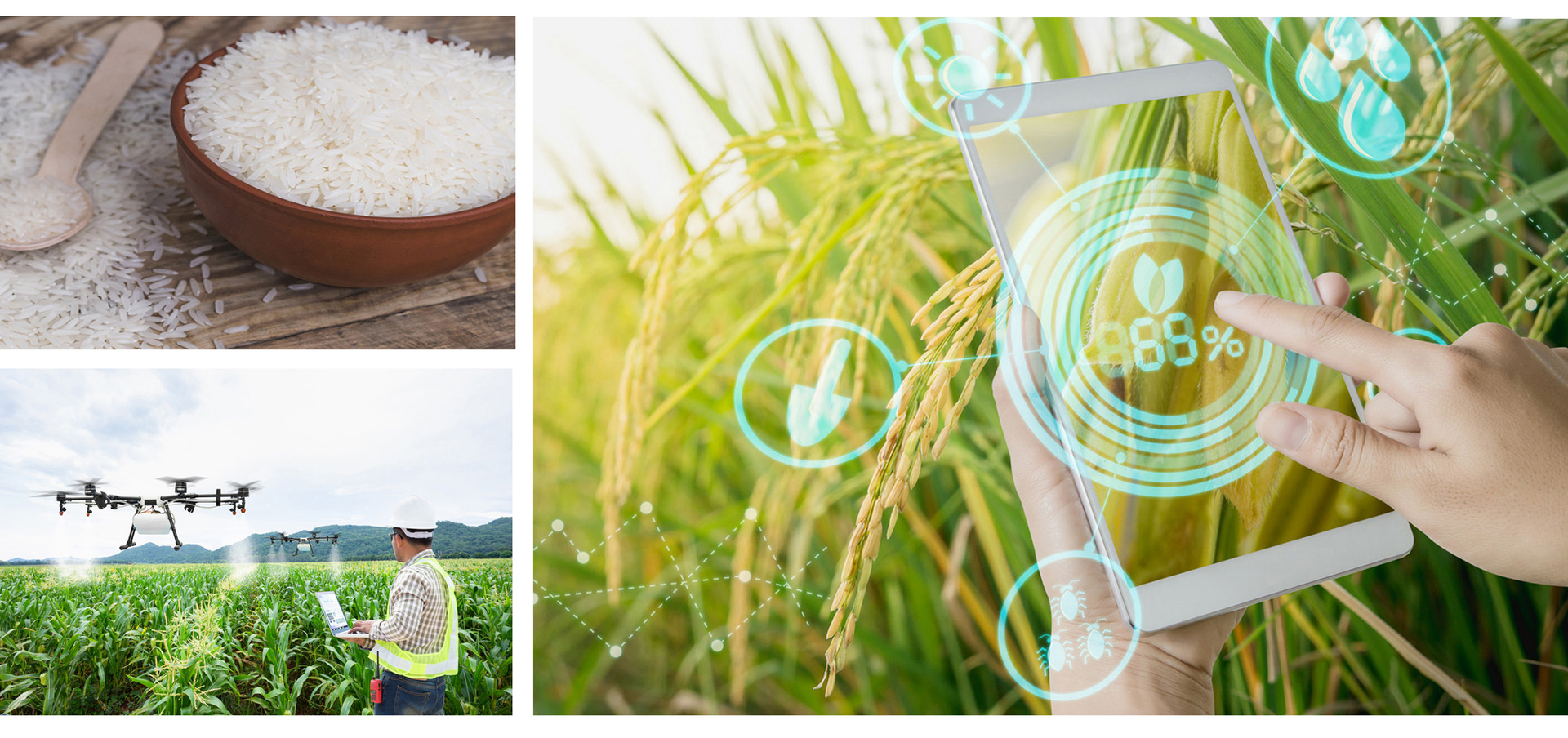
With rice, I remember in the early 2010s, we were still apprehensive about the quality of Vietnamese rice. Low quality, many forums evaluate, but now more than 90% of Vietnamese rice exports are high quality, with a large quantity of 7-8 million tons. If we look at the countries we dreamed of, Vietnam is in the top group of rice exports with high quality and high prices.
That achievement, I think comes first from the seed. It's glad we now have a proud set of rice varieties. Of course, it is not satisfactory, but it must be said that it is very good and diverse. Even the leading countries in rice production have to dream of it. It is the result of science, step by step.
A typical example is the Mekong Delta Rice Research Institute with many generations, the inheritance from Professor Nguyen Van Luat, Bui Chi Buu, Bui Ba Bong... It's emotional to look back at the photos of the Mekong Delta Rice Research Institute. Since its inception, many experts from India and IRRI have invited the Mekong River to consult and cooperate.
Generations of Presidents are all passionate about science and great scientists. That fire of passion is passed on to the next generations. Life is not rich, and facilities are more or less limited, but scientists are very passionate. Many doctors return from abroad and stay at the Institute. Resources are connected one after another, and there are rice varieties that several generations work together. Creating worthy achievements, some varieties have a planted area of nearly a million hectares annually, such as OM5451, now OM18.
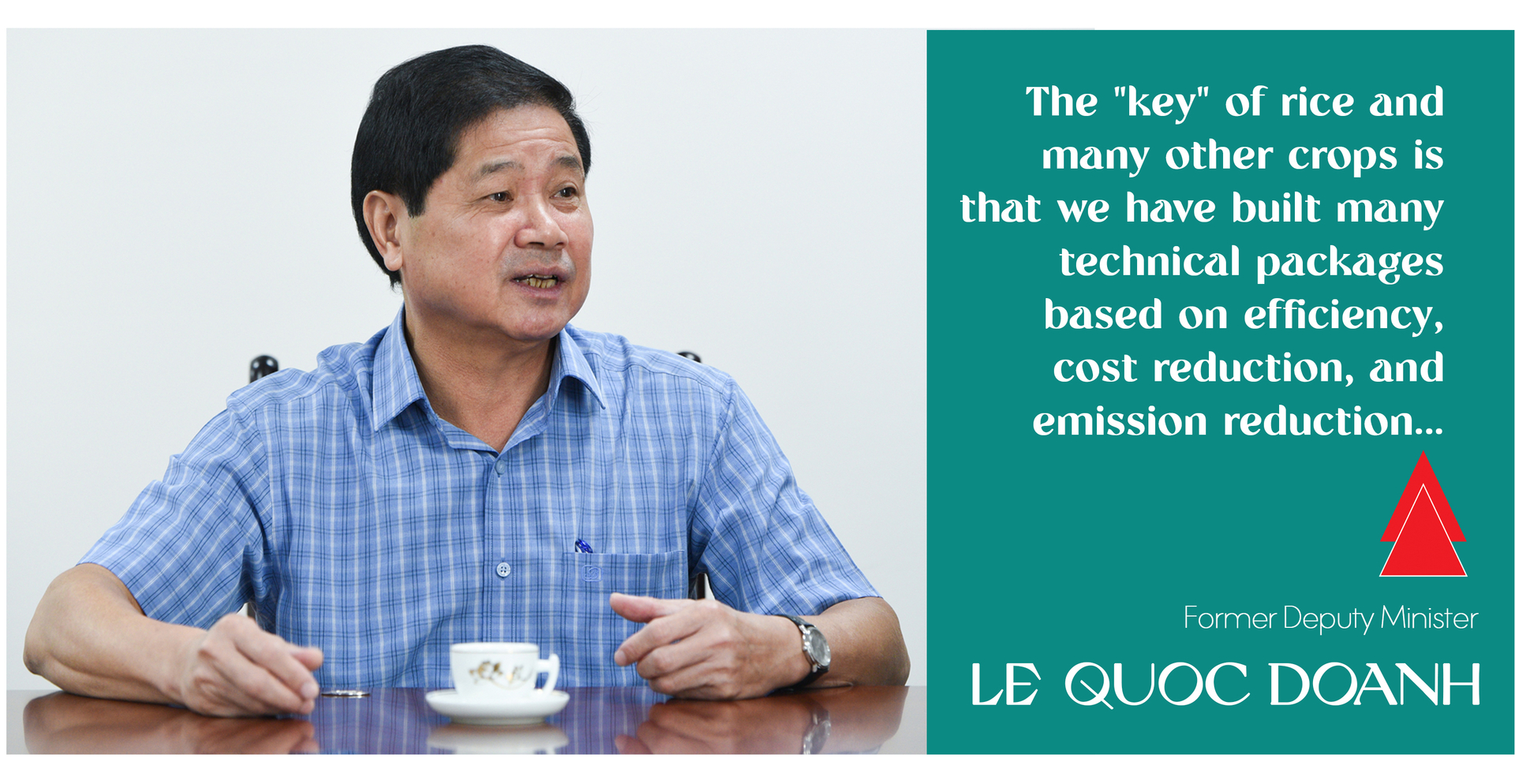
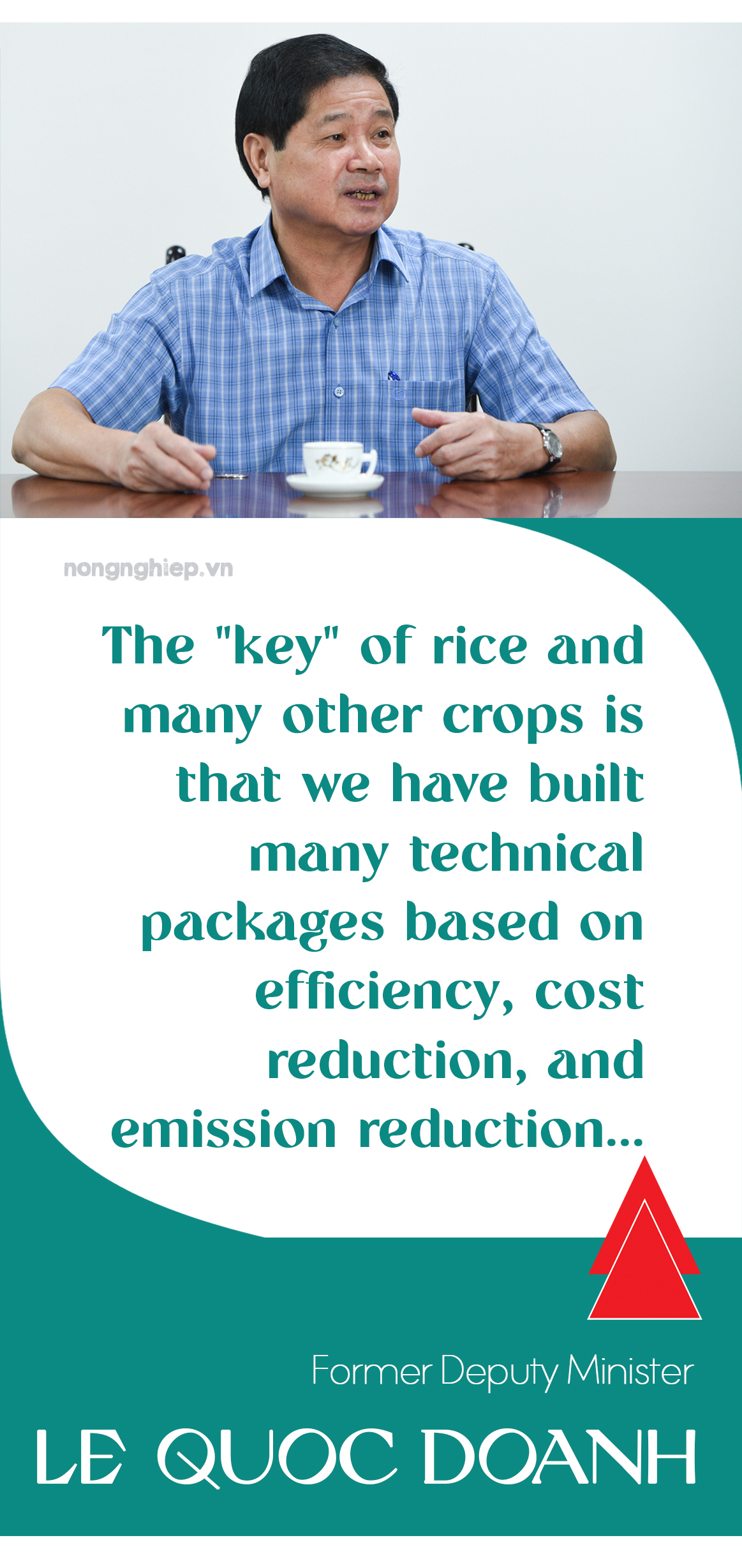
Especially in the corporate sector, we also have businesses dedicated to the industry. Vinaseed, Thaibinhseed, and many other private enterprises, connecting many generations, took many years to produce products such as BC15, Dai Thom 8, TBR225, RVT, DS1... This results from inheritance and mutual respect between generations of scientists, businesses, management leaders and farmers in production.
Technically, we have gradually improved from simple things like 3 reductions, 3 increases, 1 right, 5 reductions and are now aiming for 1 million hectares of high quality, green growth, and reduced emissions. The VnSAT project, funded by the World Bank, is considered one of the most successful projects based on science and technology. We have built technical packages based on efficiency, cost reduction, and emission reduction.
Regarding mechanization, the harvesting and land preparation stages have reached nearly 100%. Only the planting stage is still a concern. Step by step, we have repelled and controlled the epidemic with integrated pest management and farming management measures. These are technical measures accumulated from previous generations and developed.

Journalist Tran Cao: In addition to the VnSAT project sponsored by the World Bank, considered one of the brilliantly successful projects, there are other programs and projects such as IRRI, FAO, ADB, etc. What do you think about international economic cooperation for rice development and cultivation in Vietnam, especially when implementing the Project of 1 million hectares of high-quality rice associated with emission reduction, sir?
Former Deputy Minister Le Quoc Doanh: Why is rice like it is today? In addition to the joint efforts of managers, scientists, localities, business communities, and farmers, another issue is that we have exploited and cooperated exceptionally well with the international community.
The first thing to mention is the International Rice Research Institute - IRRI. This is where, for more than 60 years, many generations of Vietnamese leaders, experts, and rice researchers have been trained. In addition, IRRI also supports Vietnam with genetic resources and technical advances and brings highly qualified experts to help us.
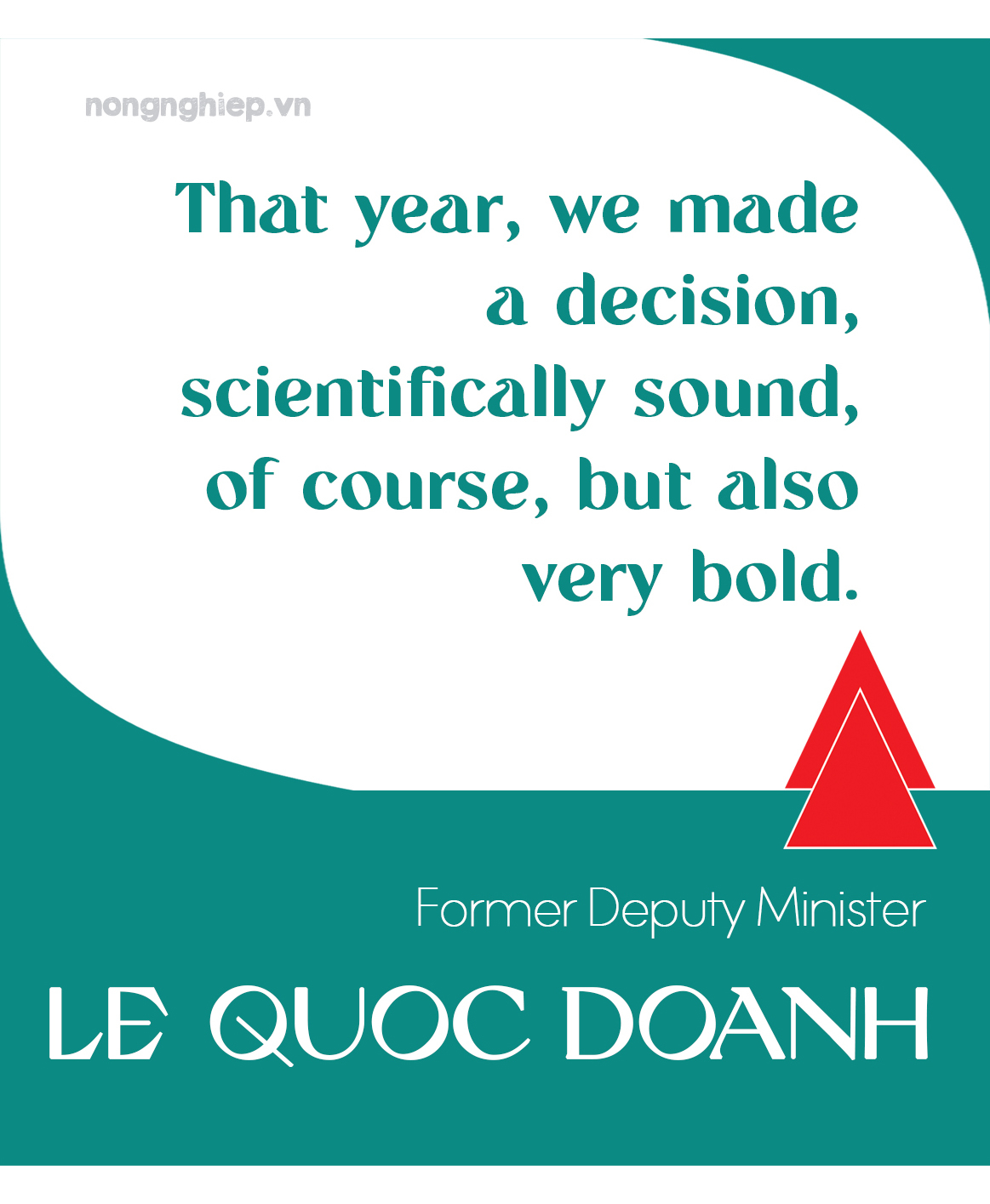
In addition, it must also be mentioned that the financial institutions and major donors such as the World Bank and Asian Development Bank invest in very large projects in infrastructure, production and technology.
Previously, we had the VnSAT project. In addition to the story of improving the quality of rice, it also contributed to reducing emissions. In the upcoming future, the project of 1 million hectares of high-quality rice associated with emission reduction is a good opportunity to continue promoting previous projects. In it, we use technical measures to reduce water, manure, seeds, and materials...
The project of 1 million hectares of high-quality rice associated with emission reduction is a good opportunity for the industry and for the Mekong Delta to promote previous successes, thereby developing linkages, organizing production, and switching to a more comprehensive stage of development and especially connecting businesses, cooperatives, localities, and farmers, creating a better environment for new technical and advanced packages to be applied faster.
We will develop in parallel between productivity, quality, and efficiency with the environment, reducing emissions. The proof is that Vietnam and IRRI have built 2 branded programs, 3 decrease 3 increase, 1 must do 5 decrease. Or for coffee, the coffee landscape project has also become a trademark of Vietnamese farming.
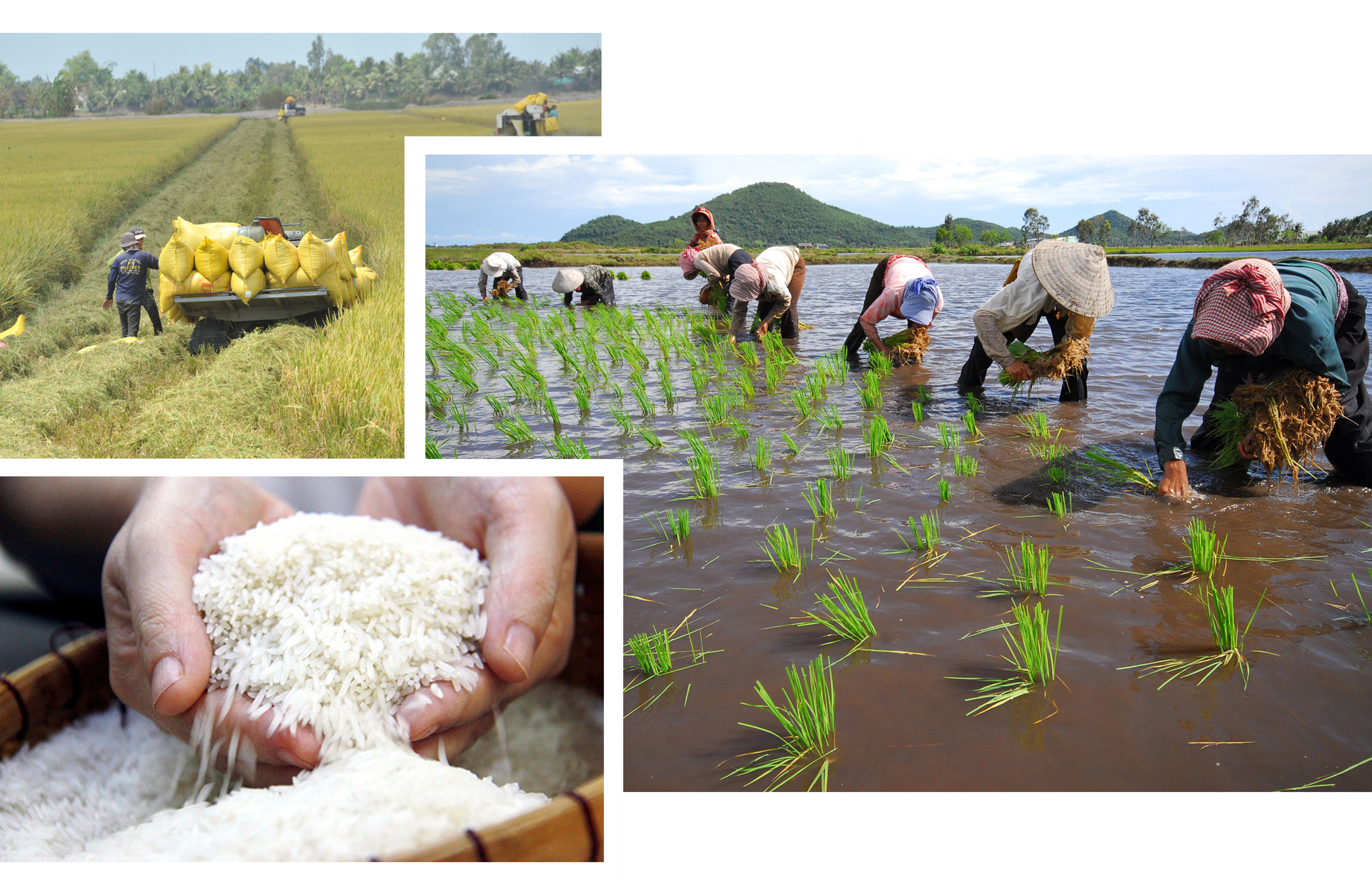
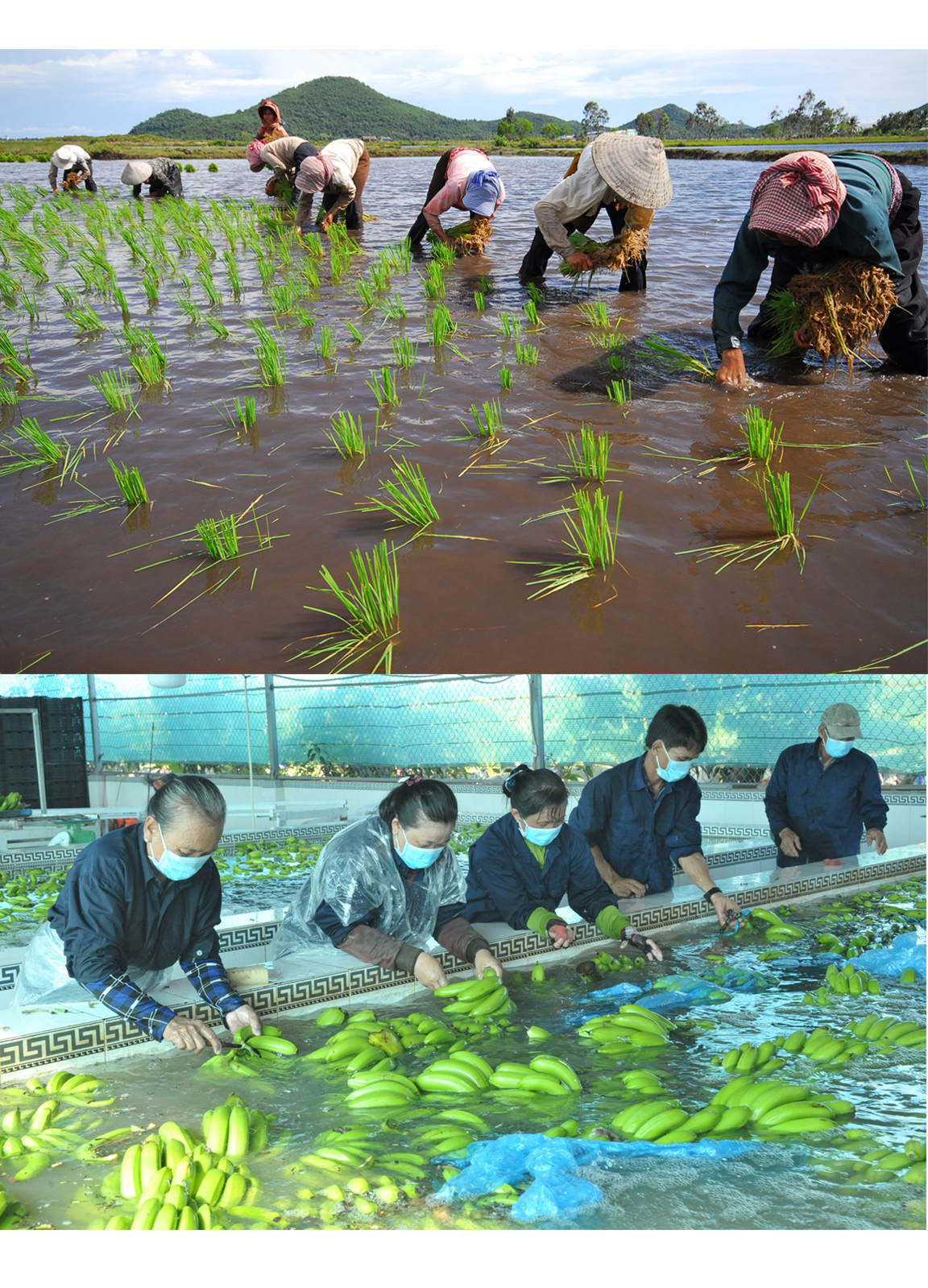
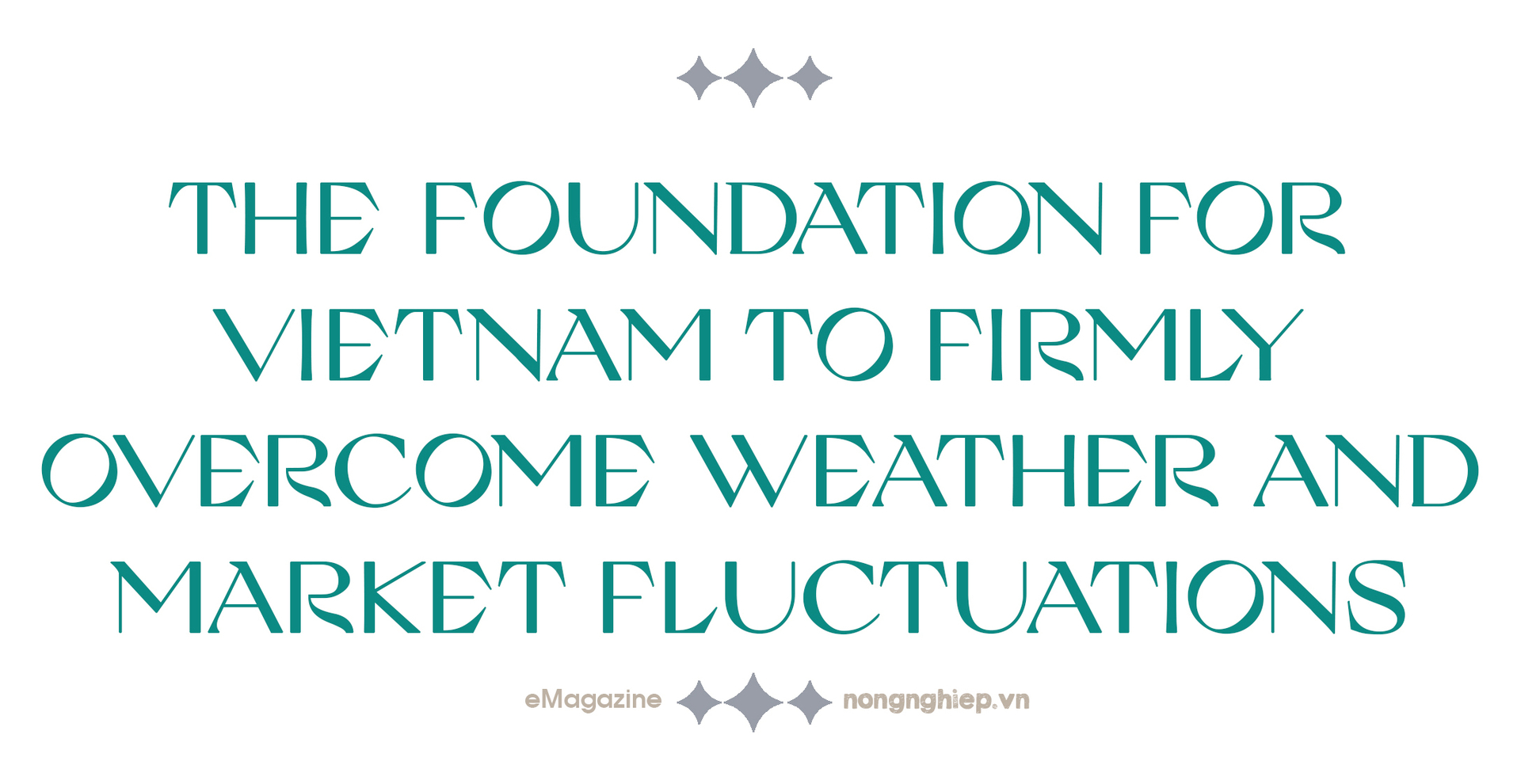
Journalist Tran Cao: Looking back at the revolution of rice and farming, in addition to the factors you have analyzed, I see that our general direction work has also adapted very quickly and flexibly to terrible climate changes, weather... Is that also the basis for the breakthrough of Vietnamese rice?
Former Deputy Minister Le Quoc Doanh: Currently, there is a story about food demand and the return of El Nino will affect production and markets, but Vietnam will firmly overcome.
The basis for saying that is that we have a good seed set, improved infrastructure, timely and thorough guidance from the central to local levels, and farmers' production experience. I witnessed the two heaviest droughts, the first being the Winter-Spring crop of 2015 - 2016.
At the end of 2015, when it was determined that drought and salinity occurred in the Mekong Delta, we came up with some solutions to guide. Localities also tried to make temporary dams, store water, and divert water. But that year, more than 1 million tons of rice were lost due to an unprecedented drought and salinity.
By 2019 - 2020, El Nino returns more fierce, but we have experience. Before holding the 2019-2020 Winter-Spring Crop Production Conference for the Mekong Delta provinces, the Ministry of Agriculture and Rural Development directed the establishment of a working group consisting of leaders of the Ministry, the Department of Crop Production, the Department of Plant Protection, and the Ministry of Agriculture and Rural Development. The National Agricultural Extension Center, the General Department of Irrigation, and related research institutes work with each province to grasp the situation and propose production plans to cope with drought and salinity.
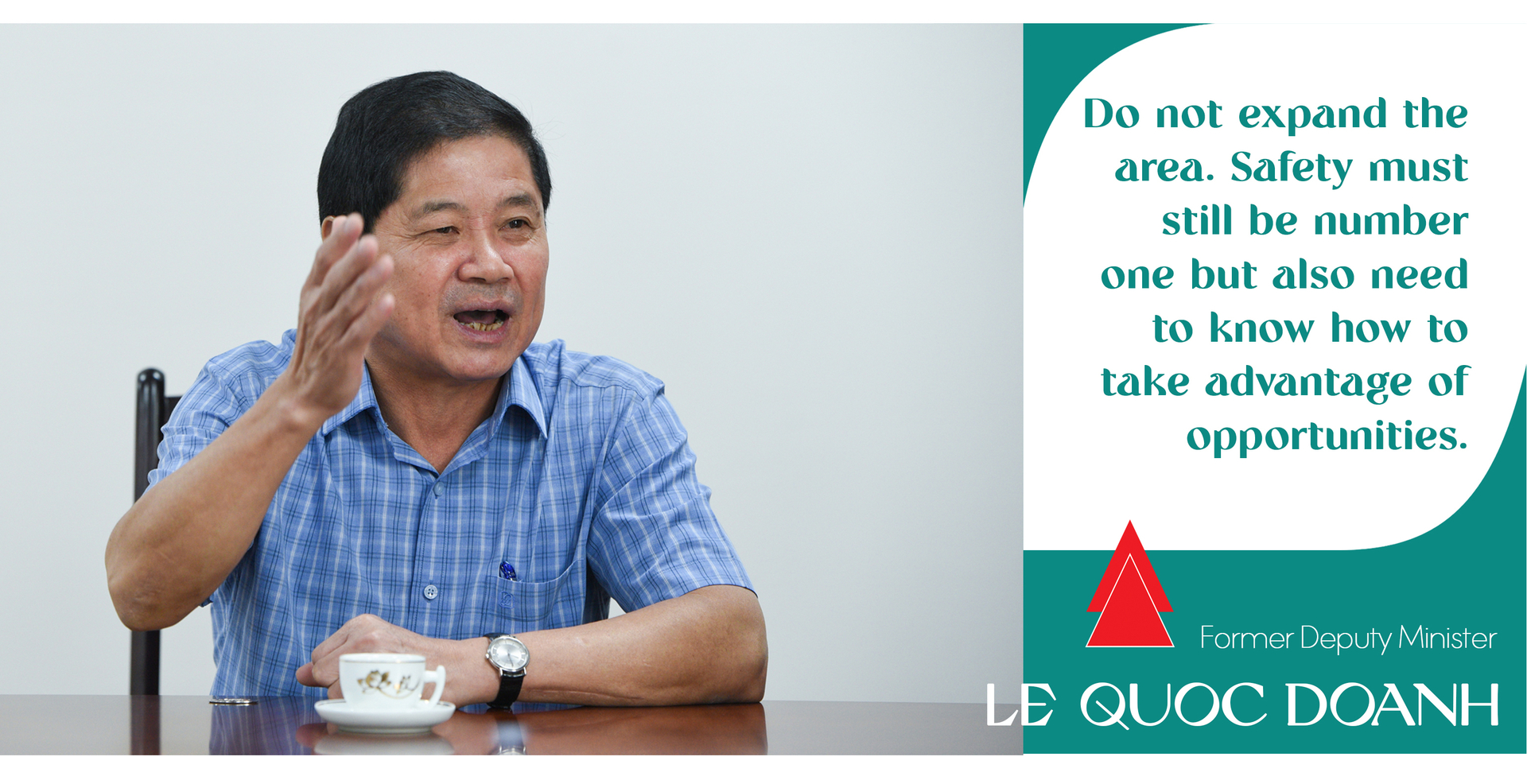
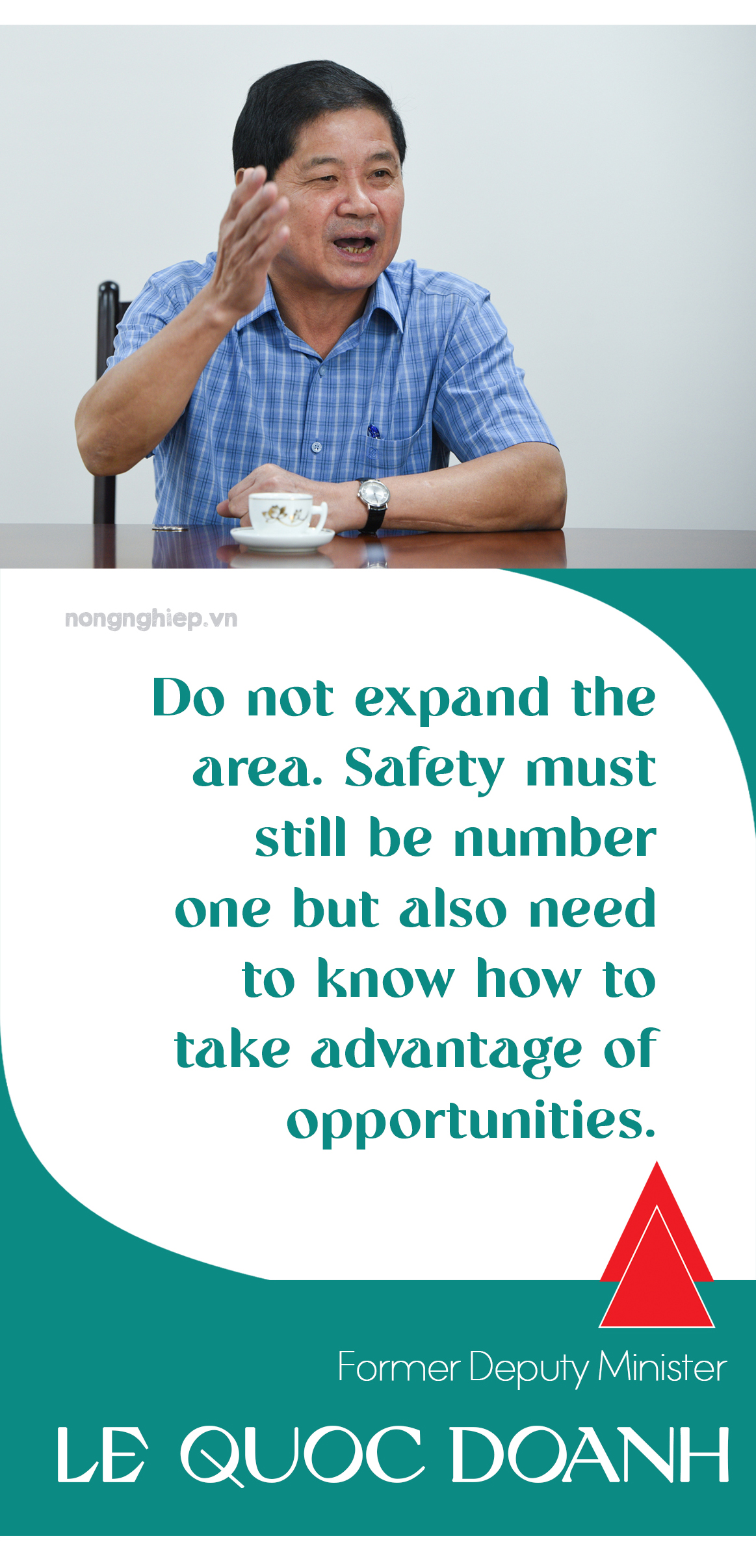
At the conference, we listened to all the units, the Department of Crop Production, the Plant Protection Department, the General Department of Irrigation, and the Center for Hydrometeorological Forecasting. After discussion, especially with local opinions, the conclusion was that many solutions are considered for rice and other crops in addition to water storage.
Accordingly, the custom in the Mekong Delta is to sow in many crops. Early crop, middle crop, late crop, coastal areas, watershed areas, and sowing seasons are different. At that time, we thought salinity was severe in February and March, mainly in the coastal areas around 50 km, it is heaviest, so why don't we sow the seeds first? When the salinity comes, we will already reap the harvest.
That year, we made a decision, scientifically sound, of course, but also very bold. Agree to speed up seeding time for 400,000 hectares of rice in 8 coastal provinces in the Mekong Delta, about 50 km from the coast.
Normally, this area sow seeds in November. That year it was decided that 400,000 hectares must be sown in October. After sowing, we regularly checked and saw that the rice was growing well, especially before Tet. When we entered, people started to harvest.
In Soc Trang, where the 2015 - 2016 Winter-Spring saltwater drought suffered the heaviest damage. We visited a field that in 2016 lost everything but in 2020 gained 8 tons/ha. Then, down to Long An, Tien Giang, the districts suffering from drought and salinity, rice is also very good. Therefore, even though El Nino occurs, it does not affect productivity or output, especially since the price of rice is higher because it is collected at harvest time. Hence, farmers have money to spend during Tet...
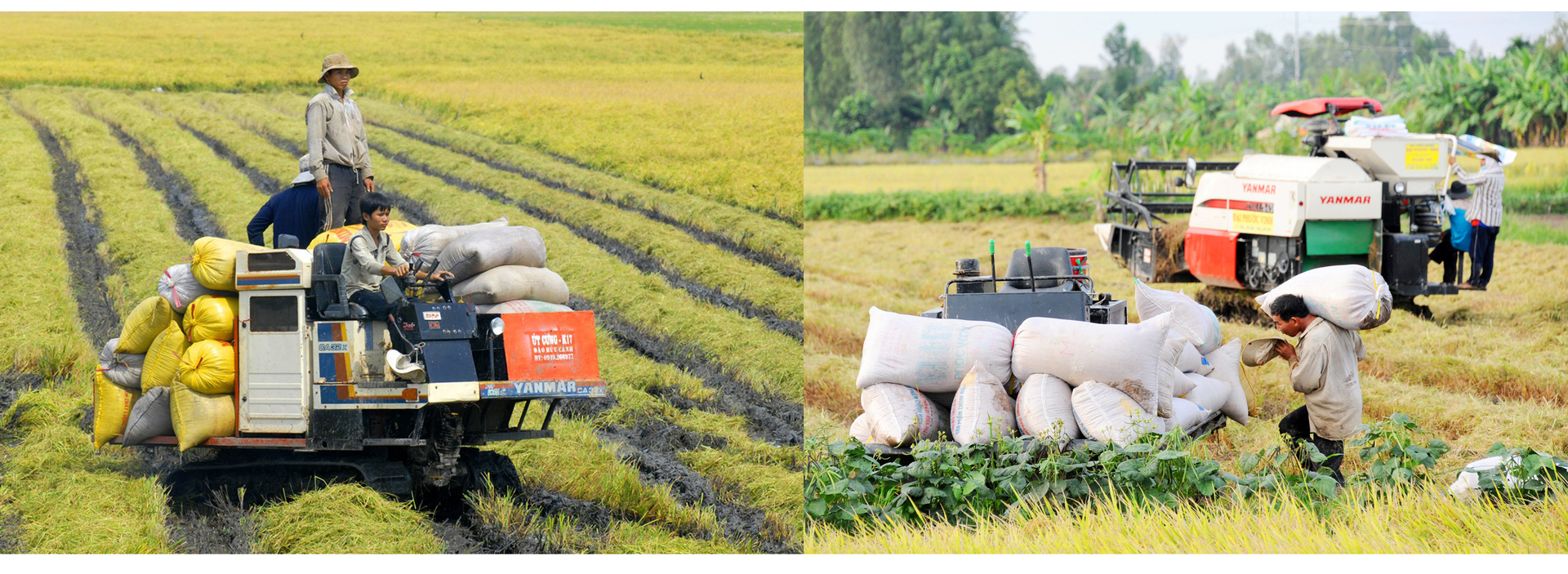
After that year, even without drought and saltwater intrusion, we continued to direct the early deployment of seeding areas, which was effective. We had time to prepare for the Summer-Autumn crop...
I think it's the right decision, we don't lose anything, we don't have to invest more, we have to listen and gather all the information. We would consider the water, the weather, varieties, techniques, pests, etc., to give the right direction.
What impressed me most was when the Ministry seriously unified the direction and leadership of the localities and farmers in the West, supported and trusted, and coordinated smoothly. Besides we must also mention the involvement of media agencies, typically Vietnam Agriculture Newspaper.
Summarizing now, these guidelines have become a favorable solution. I think that is the best solution. Recently, when comparing the effects of El Nino on rice-producing countries, Vietnam has surpassed it.

Journalist Tran Cao: That is also the basis for us to continue to change, specifically for the Mekong Delta. According to you, how will the rice picture in this region change to implement the natural solution as he analyzed?
Former Deputy Minister Le Quoc Doanh: This year, we have 2 input data to pay attention to for the Fall-Winter and Winter-Spring crops. The first is the rice price. The second is El Nino. In which, El Nino may occur during Tet, which will cause great impacts, drought, and saltwater intrusion. So what's the solution?
First, we will take advantage of export opportunities, but whatever we take advantage of must start from output, from production, to have products to sell. This is a story to be reckoned with. World prices are reasonable, but from now until the end of the year, where will the supply be? Currently, the summer-autumn rice crop is almost finished and the winter-spring rice crop won't be ready until after Tet. So, based on what?
For this year's Autumn-Winter crop, it is known that the production plan is 700,000 hectares in the Mekong Delta. However, if possible, the area should be increased further, and Autumn-Winter must be considered the main production crop.
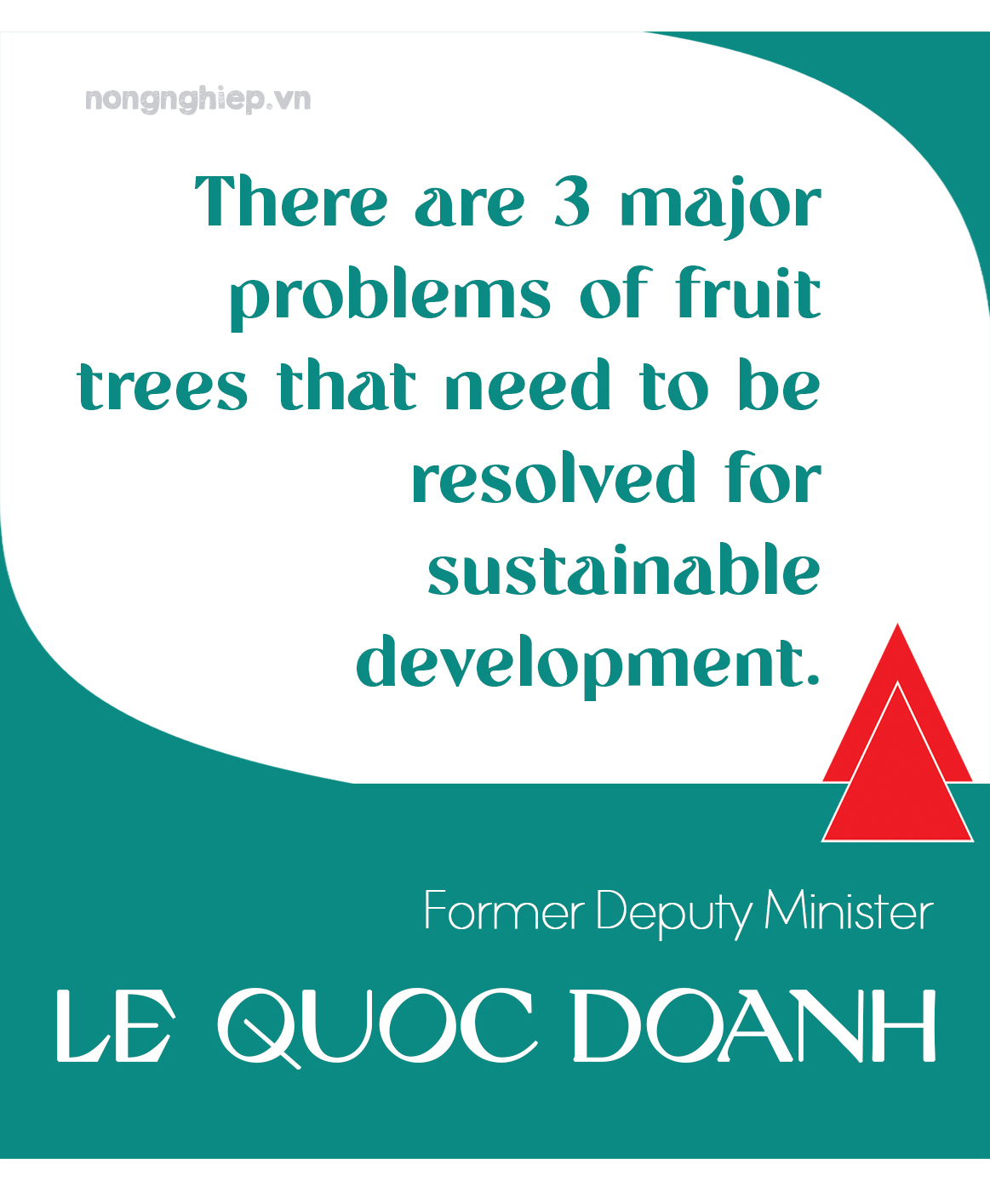
We already have a production plan for the Autumn-Winter crop. The problem is how to behave. Of course, safety must still be number one without expanding the area at all costs, but it is also necessary to take advantage of opportunities to promote this particular production.
We must prepare seeds and materials and, most importantly, control the dike to produce the best autumn-winter crop. My relatives have a lot of production experience. What is needed now is the local direction to deploy.
The Irrigation Department's forecast shows that the flood season is not too much of a concern. In recent years, floods in the Mekong Delta can be considered as beautiful floods. Therefore, we should take advantage of expanding the area of the autumn-winter crop. In the past, there were years when we directed to bring the area of this crop to over 800,000 hectares.
Second, we should sow the winter-spring crop earlier. Not only stopping at 400,000 hectares but pushing it up, building a plan to connect it with autumn and winter to have an area to harvest before Tet and avoid having to worry about drought and salinity for late winter and spring.
We must anticipate that if El Nino is strong. Coastal areas and many freshwater areas may also be affected. Therefore, if you do, you must calculate other conditions such as water sources, pests, etc. It is necessary to prepare safe conditions, but based on science and proven experience, it can ultimately push. With more area, rice will be more abundant.
The normal Winter-Spring crop has an area of about 1.6 million hectares. We can push it early so that one arrow hits two targets to meet the supply and take advantage of the favorable and limited export prices affected by El Nino in the upcoming time.
Perhaps, in the future, pushing the crops forward will become a lesson and be implemented regularly. Drought and salinity will become the default in the Mekong Delta, more or less, so why don't we do it without affecting and relaxing the labor force of the people?
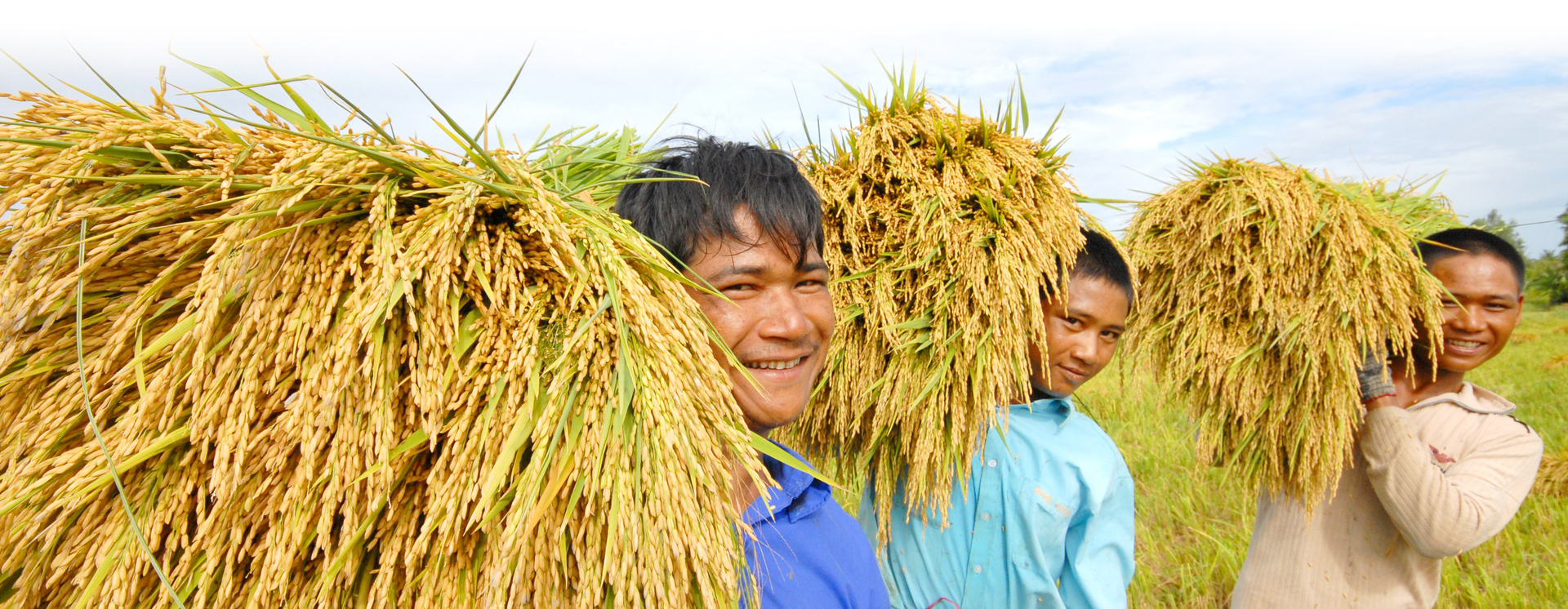
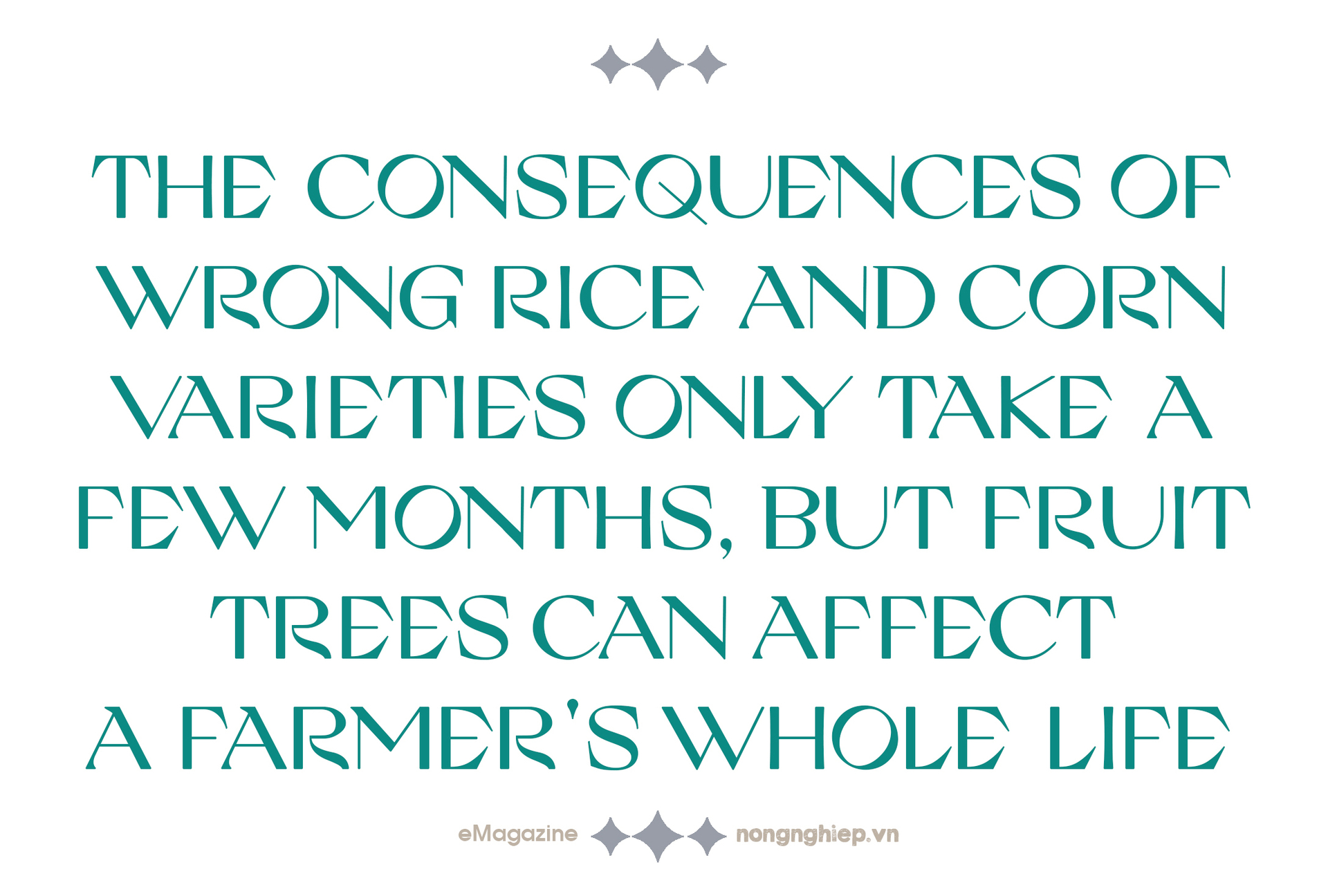
Journalist Tran Cao: From the story of rice, a very current issue is vegetables and fruits. In the first 7 months of 2023, exports of this industry reached US$ 3.23 billion. It is expected to be more than US$ 5 billion this year, an unprecedented record. Of course, that is a good thing, but there are also many concerns about the issue of overheating, epidemics, and the market... In your opinion, what is the solution to sustainable fruit and vegetable development?
Former Deputy Minister Le Quoc Doanh: When discussing agriculture today, we often question the impact of three factors: economy, environment and society. The farming field is the largest space, almost 100% attached to Vietnamese farmers. That is also something that generations of leaders of the Ministry of Agriculture and Rural Development have always wondered about. Especially with fruit trees. Although the project to develop key fruit trees to 2025 and 2030 has been approved since 2022, the development strategy is clear regarding crops and area, but there are still many problems. Especially for crops such as cashews, pepper, oranges... or others. There may be a time when the economic benefits of fruit trees are immeasurable, but in the long run, the story of the breed, how the land will be, and how the science and technology will work... are big problems.
In my experience, when considering a long-term crop, specifically fruit trees, we must consider the location, weather, climate, market, and trend. 3 major problems of fruit trees need to be resolved to develop sustainably.
The first is about seed. Rice, coffee, corn... we have great varieties that many countries dream of, but with many fruit trees nowadays, varieties are a big problem. We can still see economic effects from the billion-dollar models. Still, like I have said many times, if we mistake the rice variety, the corn variety can only take a few months to fix, but with fruit trees, it is decades, even a farmer's entire life.

The second is soil. Growing fruit trees must start from the soil. The soil must be enriched, rich in organic matter and microorganisms. The lesson of soil environmental degradation in the Central Highlands, Phu Quy, and many other areas is that if we still abuse intensive farming, chemical fertilizers, and toxic pesticides, it will have a hazardous impact on the biology of the soil. Beneficial microorganisms are killed, and the pH level drops, leaving only fungi and nematodes, inevitably leading to pests and diseases. Evidence in many orange growing areas today is that every disease is sprayed, so the more dangerous it is, the more must start from the soil. The same goes for pepper, dragon fruit, durian, banana, avocado... or many other crops.
Third, we already have a technical package for rice but not yet for fruit trees. I re-experienced among many reasons why fruit trees have not developed really sustainably. There is one crucial reason. Scientific research in this field is still limited despite our efforts and many concerns. The solutions have not been integrated into a complete technical package from seeds, soil, and care to cope with weather, pests, and diseases... Therefore, although we have identified our advantages as tropical fruit trees. Looking at the basis, the regions and localities that develop fruit trees methodically and beautifully are still few compared to the potential and advantages.
In researching and discussing fruit trees, we must calculate and harmonize the immediate and long-term benefits between the economy, the environment, and the whole society.
Journalist Tran Cao: Thank you so much for your time! We wish you good health and continue to contribute to Vietnam's agriculture.
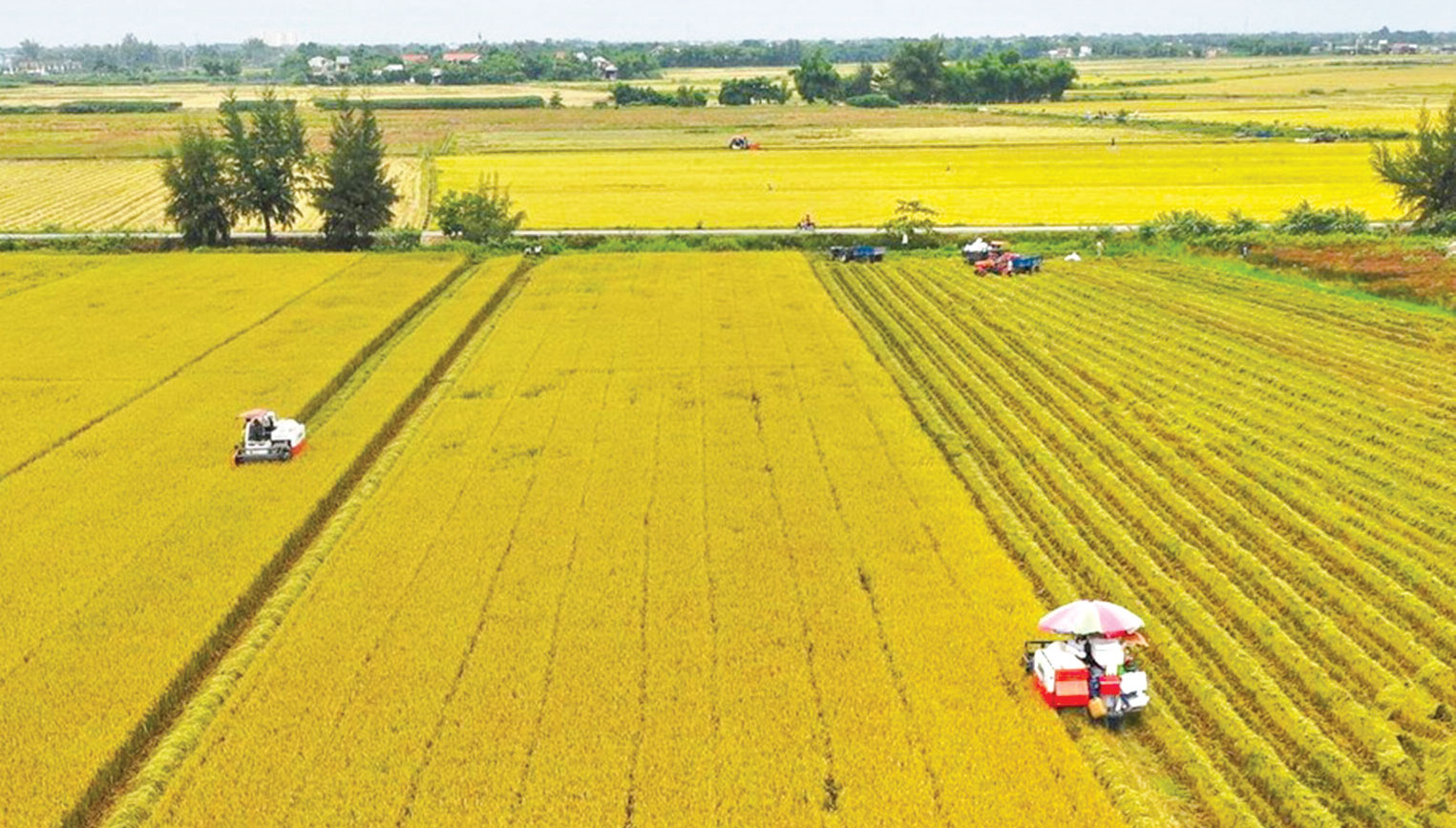
Content: Hoang Anh - Tung Dinh
Photo: Hoang Vu - Tung Dinh
Translated by: Pham Thi Huong Giang


